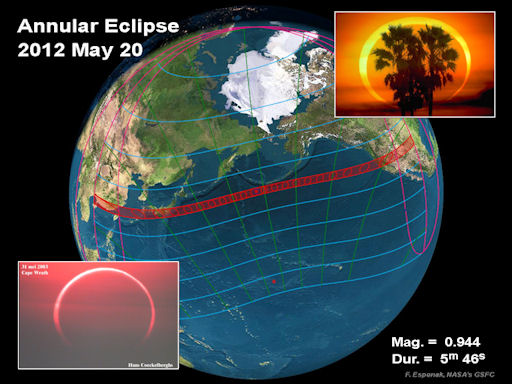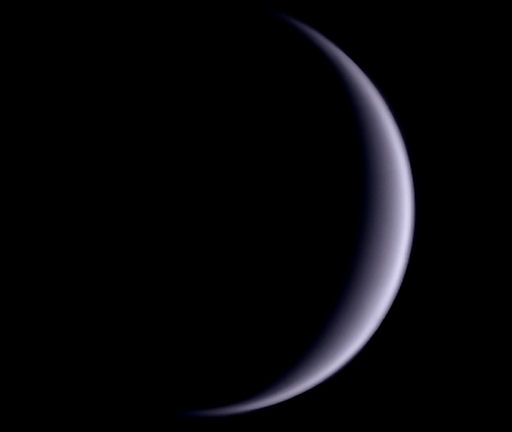2012 TRANSIT OF VENUS: It won't happen again until December 2117: On June 5th, 2012, Venus will transit the face of the sun. The best places to watch are in the mid-Pacific, but travel is not required. The event is widely visible around the world, including at sunset from the USA. [full story] [video]
SOLAR ECLIPSE THIS WEEKEND: On Sunday, May 20th, the Moon will pass in front of the Sun, producing an annular solar eclipse visible across the Pacific side of Earth. The path of annularity, where the sun will appear to be a "ring of fire," stretches from China and Japan to the middle of North America:

Image credits (left to right): Hans Coeckelberghs, Fred Espenak, Dennis Mammana
An animated eclipse map prepared by Larry Koehn of ShadowandSubstance.com shows the best times to look. In the United States, the eclipse begins at 5:30 pm PDT and lasts for two hours. Around 6:30 pm PDT, the afternoon sun will become a luminous ring in places such as Medford, Oregon; Chico, California; Reno, Nevada; St. George, Utah; Albuquerque, New Mexico, and Lubbock, Texas. Outside the narrow center line, the eclipse will be partial. Observers almost everywhere west of the Mississippi will see a crescent-shaped sun as the Moon passes by off-center.
Because this is not a total eclipse, some portion of the sun will always be exposed. To prevent eye damage, use eclipse glasses, a safely-filtered telescope, or a solar projector to observe the eclipse. You can make a handy solar projector by criss-crossing your fingers waffle-style. Rays of light beaming through the gaps will have the same shape as the eclipsed sun. Or look on the ground beneath leafy trees for crescent-shaped sunbeams and rings of light.
Solar eclipse resources:
-
Annular eclipse photo gallery -- from spaceweather.com
-
NASA feature story and video
- Animated Eclipse Map -- from shadowandsubstance.com
VENUS TRANSFORMED: Something special is happening to Venus in the evening sky. The second planet is diving toward the sun for a much-anticipated transit on June 5-6. As Venus turns its night side toward Earth, the planet is transforming into a beautifully slender and colorful crescent:
John Chumack of Dayton, Ohio, took the picture on May 14th using a 10-inch telescope. "I was blown away by the sight of Venus," he says. "The planet was 14% illuminated, 47 arcseconds in diameter, and blazing at -4.43 magnitude."
The crescent shape of Venus is easy to see in good binoculars or small telescopes. No special observing experience is required. Just find Venus in the western sky after sunset (you can't miss it), point and look. A good tripod to hold the optics steady is recommended.
As the evening wears on and Venus sinks toward the horizon, the refractive effect of Earth's atmosphere splits the crescent into the colors of the rainbow. Kevin R. Witman of Cochranville, Pennsylvania, observed the phenomenon on May 11th: "Earth's atmospheric refraction of Venus's ample light made a beautiful image through my 10-inch telescope."
more images: from Mark Marquette of Boones Creek, Tennessee; from Philippe Vanden Doorn of Rixensart, Belgium; from Luis Argerich of Buenos Aires, Argentina; from Tomasz Gołombek of Tczew, Poland; from Francesc Pruneda of Palamós, Catalonia (Spain); from Sadegh Ghomizadeh of Tehran, Iran;

![]()
Solar wind
speed: 399.8 km/sec
density: 1.0 protons/cm3
explanation | more data
Updated: Today at 1725 UT
![]()
X-ray Solar Flares
6-hr max: C1 1218 UT May19
24-hr: C2 0000 UT May19
explanation | more data
Updated: Today at: 1700 UT
![]()
![]()
![]()
Daily Sun: 19 May 12
![]()
![]()
None of the sunspots on the Earthside of the sun is actively flaring. Credit: SDO/HMI
![]()
![]()
![]()
Sunspot number: 118
What is the sunspot number?
Updated 18 May 2012
Spotless Days
Current Stretch: 0 days
2012 total: 0 days (0%)
2011 total: 2 days (<1%)
2010 total: 51 days (14%)
2009 total: 260 days (71%)
Since 2004: 821 days
Typical Solar Min: 486 days
Updated 18 May 2012
The Radio Sun
10.7 cm flux: 132 sfu
explanation | more data
Updated 18 May 2012
![]()
![]()
![]()
Current Auroral Oval:
![]()
Switch to: Europe, USA, New Zealand, Antarctica
Credit: NOAA/POES
![]()
![]()
![]()
Planetary K-index
Now: Kp= 1 quiet
24-hr max: Kp= 2 quiet
explanation | more data
![]()
Interplanetary Mag. Field
Btotal: 3.5 nT
Bz: 2.9 nT north
explanation | more data
Updated: Today at 1726 UT
![]()
![]()
![]()
Coronal Holes: 19 May 12
![]()
![]()
There are no large coronal holes on the Earthside of the sun. Credit: SDO/AIA





